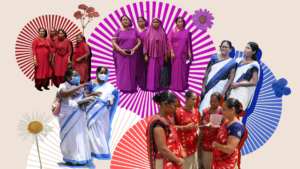What Time Use Surveys Say And Don’t About Women’s Work
Last month, the government released a factsheet of the key findings from the Time Use Survey conducted in 2024. The survey, with crucial data on how women spend their days is also sensitive to errors

India’s second and latest national time use survey (TUS), a crucial data source on how people spend time on economic and non-economic activities and on gendered labour divisions, is marred by methodological errors that impact its findings. These flaws had also dogged the very first such survey conducted in 2019.
In February, the central government released a factsheet of initial findings of the 2024 survey, which showed that little has changed in the last five years on how women in the country spend their time. While the annual labour force surveys showed a marked increase in women’s participation in the labour force from 24.5% in 2018-19 to 41.7% in 2023-24, the average time that women spent on paid activities increased by only 6 minutes from 56 in 2019 to 62 in 2024. And the time spent on unpaid activities such as caring for household members, cooking and cleaning, remained the same – 5 hours and 5 minutes.
The TUS collects data over a 24-hour cycle to provide a more granular picture of how people spend their day. It is a prominent source of data especially for estimating how much of women’s labour (paid and unpaid) goes unacknowledged. Care work, a crucial labour that builds economies, has been primarily gendered and structurally unaccounted for in the calculation of national income.
The biggest problem with the TUS, as we detail later, is that more than a third of the responses come from other household members and not the person being surveyed. The survey also does not provide necessary contextual information such as exactly how care is structured in a household, who owns its assets or who performs which particular task within a sector like agriculture or animal husbandry.
Another problem is that the TUS does not have any synergy with the labour force surveys that provide a broader understanding of employment patterns. This means that we do not have that crucial insight into the links between employment and time use.
Though five years passed between the first and second surveys, the problems with collection methodology remain – how are the questions asked, who is included as a respondent and how are activities harmonised and categorised.
Evolution of Time Use Surveys
The first such surveys in India were conducted by independent researchers in the late 1970s but the first central government efforts were in 1998 with a pilot survey covering six states.
How did the idea of a TUS take root? It began as a Marxist tool to understand the division of time between different types of peasant work in the 19th century. Before 1900, Russian administrative units, driven by the Marxist notions of determining the value of objects on the basis of their labour input, were tasked with observing peasant workers and creating a time balance sheet of different kinds of labour. In 1913, two time use studies were conducted in London—one to address food distribution inequalities related to poverty and high infant mortality and another on factory workers.
By the late 1920s, the United States Department of Agriculture started collecting data on “farm”, “town” and later, elite, educated “college” women. These surveys, which constitute the earliest individual level data that researchers can still use, became crucial evidence in showing the increase in unpaid care work after the technological advancement in the manufacture of labour-saving electronic goods such as washing machines, refrigerators and geysers. But it soon became clear that this revolution also increased the workload on women. For example, clothes would be ‘dirty’ and put to wash after a single-use; people started shopping more and child-raising practices got more elaborate.
By the 1960s, time use studies were being conducted on a large-scale in many European countries and in Japan. In the mid-1960s, the United Nations Educational, Scientific and Cultural Organization (UNESCO) funded a 12-country cross-national time use study which became the model for present-day surveys.
In India a pioneering, small scale attempt at conducting a time use survey was made in two districts in 1976 by researcher Devaki Jain – in three villages of Rajasthan’s Barmer district and three in West Bengal’s Birbhum district.
In a paper summarising her findings, Devaki said: “All women’s work yields an output but all women’s work does not provide an income. For an assetless worker, it is her time more than her wage that measures her labour. Time itself can be used as a valuator. Time as a measure of value, would reverse the values of men and women’s work—women would always come on ‘top’ as they spend more hours working than men.”
In 1983, the National Council of Applied Economic Research (NCAER) conducted a time-allocation study and in 1996, Tamil Nadu’s Directorate of Economics & Statistics conducted a pilot survey.
But the first attempt by the central government came in 1998 when a pilot survey was conducted in six states—Kerala, Meghalaya, Haryana, Madhya Pradesh, Odisha and Gujarat. This survey showed that around 58% of rural women engaged in economic activity while the labour force survey showed it to be 25%.
Underreporting Women’s Labour
Time use surveys are largely conducted in two ways–an interview-based approach or a diary-approach. In the first, respondents are given a pre-set list of activities and are asked how long they spend on each activity in the specific time period. In the diary-approach, respondents list out their activities over the specified time period in their own words, which is then collated and then coded into data.
Instead of the specific questions of other surveys, time use encodes a person’s entire day into data. It helps with evidence of labour that is unaddressed, unaccounted or undercounted and this is precisely why these surveys are important. Women in India, in addition to providing unpaid care work, also engage in unpaid economic labour which does not get counted as work.
The extent of this work often goes underreported in labour force surveys because the surveyors typically ask heads of households about the activities of the members of the household. Male heads might just list household chores and caregiving activities for women while underreporting their economic labour, said Vijayamba R, assistant professor at the National Law School of India University (NLSIU) Bengaluru.
In 2020, researchers from the Azim Premji University, the Indian Institute of Management, Bangalore (IIMB), and the University of Western Australia conducted a survey of over 3,500 households in Karnataka and Rajasthan. A paper based on analysis of this data showed that men underestimate women’s employment, compared to women’s estimates.
The first author of the paper and economist with Azim Premji University’s Centre for Sustainable Employment, Rosa Abraham said that most labour force surveys only have one question on the major activity status which is how they discern whether somebody is employed or not. “Instead of asking this one question, we called out different kinds of employment activities, we found that women are more likely to report themselves as employed,” she said.
Vijayamba listed similar reasons for why time-diary based surveys provide a better estimate. “In the case of the Time Use Survey, the respondents are asked to report what they have done from the time of waking up on any day to the next day. So in that case, people are not identifying what they’re doing, rather they are just reporting their activities,” she said.
Since time-use captures the previous day’s participation, the effort for recall is minimal, said Deepti Sharma, visiting assistant professor at Ahmedabad University. Another advantage is their ability to capture multiple and simultaneous activities, providing a more accurate picture of women’s labour.
Errors That Creep In
While time use surveys capture the nature of women’s work better, they can also have many methodological errors that impact the robustness of the findings.
In India, the enumerators who conduct the survey, speak to the respondents and fill out the form. In addition to background information on name, age, marital status and education, the form asks them to note down how they spent every 30-minute of the last 24 hours and assign a 3-digit code based on a pre-decided classification of activities.
Information collected through such stylised questions are known to have a high degree of errors, said Neetha N in 2010 while critiquing the 1998-99 survey. “The most important error arises from the assumption that like paid economic activity, unpaid work is performed continuously and is measurable,” she wrote.
Classification and encoding of activities into specific categories is a challenging process in the time use methodology. In 2012, an expert group under the chairmanship of a former member of the then Planning Commission was tasked with finalising a National Classification of Activities for Time Use Survey (NCATUS).
The classification that emerged had nine major groups of activities and was aligned with the National Industrial Classification (NIC) 2008, an existing standardised classification of all economic activities, using which different fields of data on industrial production, labour statistics and national income become comparable.
Of the nine categories, first three were for economic activities in primary, secondary and tertiary sectors, falling within the boundaries of production as defined by the System of National Accounts (SNA), an internationally-agreed standard set of recommendations which provide guidance on how countries should measure their economic activity, including measuring aggregates like GDP.
The next three categories were for non-market productive activities and included household maintenance, providing care for dependents and voluntary activities. The last three categories made for purely non-economic activities, also called non-SNA activities and made for learning, socialisation and personal care and maintenance activities, which also includes sleep. A pilot survey was conducted in Bihar and Gujarat based on this classification but it did not find success.
Missing Indian Context
In 2019, the National Statistical Office (NSO) conducted the first nationwide survey and used the International Classification of Activities for Time Use Statistics 2016 (ICATUS), developed by the United Nations. This survey collected data on time use from 4 am to 4 am next day for one day in a week. The 24 hours was split into 30-minute slots with each slot collecting a maximum of three activities. Only activities where more than 10 minutes were spent was included and the major activity in a slot was decided based on how important it was for the respondent.
For example, if a person milks a cow and harvests some vegetables while cooking food within a half an hour slot, all three will be mentioned only if she spent at least 10 minutes on each. And of the three, she will be asked which she considers is the major activity, and that will be noted as major while the other two will be called minor activities.
“If a woman is asked to identify a major and minor activity between two activities in a slot, often, the economic activity might not be identified as major,” said Vijayamba. “Because they are so conditioned to think that their engagement in domestic work and taking care of children is their identified activity. They might leave out the other activities such as taking care of animals, or being part of the household economic activity such as rolling bidis or making agarbattis.”
While the survey was conducted systematically, there were conceptual and methodological errors, wrote Indira Hirway, director and professor of economics at the Centre for Development Alternatives in Ahmedabad.
Indira created the classifications pertaining to non-SNA activities as a non-official member of the 2012 expert group.
Because of the as-is use of ICATUS without classifying activities in the Indian context, the 2019 survey did not reflect the intricacies of women’s care work. It could not differentiate between the contributions of women to varied animal husbandry activities as they were not listed clearly in ICATUS.
“The ICATUS has missed out on sub activities. We have the information whether a person is engaged in crop farming or livestock rearing as a paid activity or for own use. But we do not know if they are harvesting or weeding or milking animals, feeding them or harvesting fodder for them or taking them out for grazing. Such information, which is important in the Indian context, is missing,” said Vijayamba.
The background questionnaire too fell short of the survey’s 2019 objective of learning about care activities and economy. For this, it is important to figure out the details of persons needing care in a household, and the ways in which care is organised at the household level – how it is accessed from the market, government or civil society organisations, and how much care is given by household members, wrote Indira.
Another major issue that Indira highlights is the lack of synergy between the time-use survey and the labour force survey. Because time use only is meant to measure the participation of men and women in different kinds of paid and unpaid activities, it cannot measure employment and must be aligned with the labour force surveys.
The International Labour Organization defines a worker as someone who has worked at least one hour in the reference week. But a person who has worked less than an hour on the selected day in time use survey cannot be categorised as a worker or a nonworker because it doesn’t tell us what their other days in the week look like. They might be spending multiple hours on other days of the week working and hence time use could underestimate their labour.
But since time use surveys don’t have similar samples as labour force surveys, the findings cannot be analysed with context from the employment-related data from labour force surveys.
Another prominent issue is the high levels of proxy responses, where a household member answers the questions in place of the person whose time use is being captured. This is done when the main respondent is not available. In the 2019 survey, 36% of the responses were proxies. This has gendered impacts on survey results, said Deepti, the author of the paper, Does It Matter Who You Ask For Time Use Data?, that compared how proxy responses differ from self-reports.
Proxy estimates for employment-related activities are higher for women than men while it is the reverse for production of self-consumption and unpaid domestic work. Around 60% of the proxies are women, said Deepti. “Women proxies overestimate employment-related activities for both men and women while underestimate the number of hours spent on carework for women,” she said, adding that male proxies have a clearer understanding of the time use of the people they are proxy for.
These biases are less when the person and the proxy have the same occupation or education levels or similar age profile, added Deepti. Female proxies underestimate women’s time spent on unpaid domestic work by as much as 66 minutes. This might be due to “household dynamics between adult women where they might not be ready to recognize each other’s contributions,” said the paper.
An Ideal Survey
The full report of the time use survey conducted last year is yet to be released but the same mistakes are being continued, said Indira. “I have criticised the concepts and methods of time use survey of 2019, but the same problems are repeated even today,” she said. “In a situation where you do not get correct data, I do not understand what the point is in conducting the new survey and comparing with the earlier.”
In her critique, Indira had also listed a series of recommendations that can improve the survey design and methodology. The first one was ensuring labour force survey and the time use survey select similar samples and have common households and respondents. Others include improved background questionnaires that are driven by survey objectives, collating data on two days—a weekday and weekly variant day–meaning any day in a week when the routine changes–or a day selected by proper randomisation and collating more contextual information like where the activity is being performed.
Addressing the proxy issue and correcting for it is extremely important, said Deepti. “NSO should do something to take into account these proxy responses because given the disposition of time use surveys, the biases that can come is more intense than that in other surveys.” she added. According to her, in an ideal world, if one person in a sample is unavailable then they should be replaced by a person who is identical to them.
Vijayamba also spoke of improved background questionnaires that include asset ownership data and adding more activities in the ICATUS classification. And beyond this, periodicity is crucial, she said, adding, “Rather than having no data at all, it is very important to have periodic time use data on a larger scale to increase the conversation on women’s labour in subsistence and informal economic activities that go unrecorded.”
We believe everyone deserves equal access to accurate news. Support from our readers enables us to keep our journalism open and free for everyone, all over the world.




